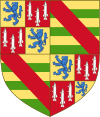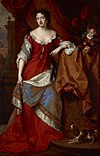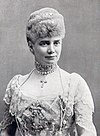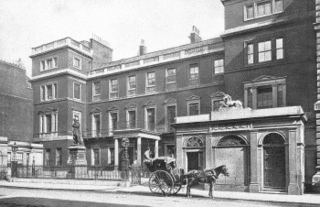
Anne was Queen of England, Scotland and Ireland from 8 March 1702 until 1 May 1707. On 1 May 1707, under the Acts of Union, the kingdoms of England and Scotland united as a single sovereign state known as Great Britain. Anne continued to reign as Queen of Great Britain and Ireland until her death in 1714.

Marlborough House, a Grade I listed mansion in St James's, City of Westminster, London, is the headquarters of the Commonwealth of Nations and the seat of the Commonwealth Secretariat. It was built in 1711 for Sarah Churchill, Duchess of Marlborough, the favourite and confidante of Queen Anne. For over a century it served as the London residence of the dukes of Marlborough. It became a royal residence through the 19th century and first half of the 20th. The house was expanded for the Prince of Wales, the future king Edward VII, and became closely associated with the prince in the Victorian era. Queen Mary lived there when she was Princess of Wales and took a special interest in the house; she returned to live there in her widowhood. The building was leased by Queen Elizabeth II to the Commonwealth Secretariat beginning in 1965.

Charles Seymour, 6th Duke of Somerset, known by the epithet "The Proud Duke", was an English aristocrat and courtier. He rebuilt Petworth House in Sussex, the ancient Percy seat inherited from his wife, in the palatial form which survives today. According to the Encyclopædia Britannica Eleventh Edition, he was a remarkably handsome man, and inordinately fond of taking a conspicuous part in court ceremonial; his vanity, which earned him the sobriquet of "the proud duke", was a byword among his contemporaries and was the subject of numerous anecdotes; Macaulay described him as "a man in whom the pride of birth and rank amounted almost to a disease".

Prince George of Denmark and Norway was the husband of Anne, Queen of Great Britain. He was the consort of the British monarch from Anne's accession on 8 March 1702 until his death in 1708.

Baron de Ros of Helmsley is the premier baron in the Peerage of England, created in 1288/89 for William de Ros, with precedence to 24 December 1264. Premier baron is a designation and status awarded to the holder of the most ancient extant barony of the Peerage of England. Before the Dissolution of the Monasteries the Prior of the Order of St John in England was deemed the premier baron.

Earl of Cromartie is a title that has been created twice, both for members of the Mackenzie family. It was first created as Earl of Cromarty in the Peerage of Scotland in 1703 for Sir George Mackenzie, 2nd Baronet, but his titles were forfeited after the Jacobite rising of 1745. It was recreated in 1861 in the Peerage of the United Kingdom for Anne Sutherland-Leveson-Gower, Duchess of Sutherland. Since 1979, the Earl of Cromartie has been chief of Clan Mackenzie.

Duchess of Kent is the principal courtesy title used by the wife of the Duke of Kent. There have been four titles referring to Kent since the 18th century. The current duchess is Katharine, the wife of Prince Edward. He inherited the dukedom on 25 August 1942 upon the death of his father, Prince George, the fourth son of George V.

Pall Mall is a street in the St James's area of the City of Westminster, Central London. It connects St James's Street to Trafalgar Square and is a section of the regional A4 road. The street's name is derived from pall-mall, a ball game played there during the 17th century, which in turn is derived from the Italian pallamaglio, literally "ball-mallet".

Baron Greenwich was a title in the Peerage of the United Kingdom that has been created twice in British history.

St James's is a central district in the City of Westminster, London, forming part of the West End. The area was once part of the northwestern gardens and parks of St. James's Palace. During the Restoration in the 17th century, the area was developed as a residential location for the British aristocracy, and around the 19th century was the focus of the development of their gentlemen's clubs. Once part of the parish of St Martin in the Fields, much of it formed the parish of St James from 1685 to 1922. Since the Second World War the area has transitioned from residential to commercial use.

Elizabeth de Burgh, Duchess of Clarence, suo jure 4th Countess of Ulster and 5th Baroness of Connaught was a Norman-Irish noblewoman who married Lionel of Antwerp, 1st Duke of Clarence.
Baron Wake of Liddell is an abeyant title in the Peerage of England. It was created in 1295 for John Wake. It has been in abeyance since 1408.
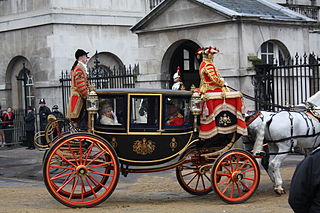
Lady of the Bedchamber is the title of a lady-in-waiting holding the official position of personal attendant on a British queen regnant or queen consort. The position is traditionally held by the wife of a peer. A lady of the bedchamber would give instructions to the women of the bedchamber on what their queen wished them to do, or may carry out those duties herself.
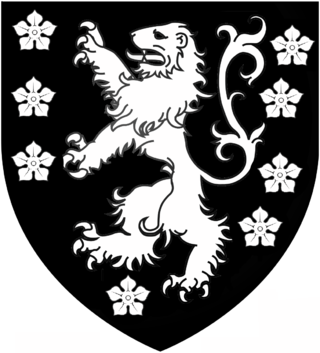
Katherine Clifton, 2nd Baroness Clifton, was an English-born Scottish peer.

Anne, Duchess of Cumberland and Strathearn was a member of the British royal family, the wife of Prince Henry, Duke of Cumberland and Strathearn. Her sister was Lady Elizabeth Luttrell who was her companion and managed her home.

Elizabeth Seymour, Duchess of Somerset and suo jureBaroness Percy was an English heiress. She was styled Lady Elizabeth Percy between 1667 and 1679, Countess of Ogle between 1679 and 1681, Lady Elizabeth Thynne between 1681 and 1682, and Duchess of Somerset between 1682 and 1722. She was the only surviving child and sole heiress of Joceline Percy, 11th Earl of Northumberland (1644–1670). Lady Elizabeth was one of the closest personal friends of Queen Anne, which led Jonathan Swift to direct at her one of his sharpest satires, The Windsor Prophecy, in which she was called "Carrots".
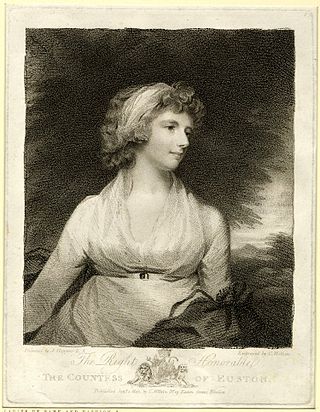
Charlotte Fitzroy, Countess of Euston, formerly Lady Charlotte Maria Waldegrave, was the wife of George FitzRoy, 4th Duke of Grafton. Although she is sometimes referred to as "Duchess of Grafton", her husband did not inherit the dukedom until 1811, after his wife's death.
Elizabeth Butler, Duchess of Ormond and 2nd Baroness Dingwall reunited the Ormond estate as her maternal grandfather, Black Tom, 10th Earl of Ormond had it, by marrying James Butler, later Duke of Ormond, her second cousin once removed. She had inherited her share of the Ormond estate through her mother, Elizabeth Preston, who was Black Tom's daughter and only surviving child. Her husband had inherited his share from his grandfather Walter Butler, 11th Earl of Ormond, Black Tom's successor in the earldom. Her share was the bigger one and included Kilkenny Castle.

